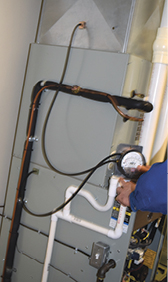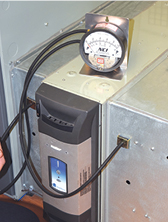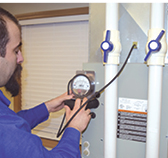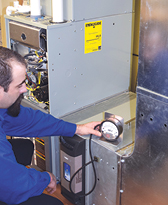
to take coil pressure drop readings.
If coil pressure drop is excessive, you should do an additional diagnostic. Inspect the coil to see if it is loaded with dust, cellulose insulation, pet dander, or other airborne pollutants. If you do find these issues, clean, repair or in extreme circumstances, replace the coil.
You may be surprised to find a clean or new coil that is overly restrictive to airflow. This is a tough one to explain to your customers because it reveals a design problem when the system was built and it may still be quite new. As a fresh overview, check your measured coil pressure drop against the coil manufacturer’s pressure drop data to verify the coil is not internally packed with debris.
Air Filter Pressure Drop
The duct system terminates or lands at the air filter. Some air filter efficiency is made possible by increasing the density of the filters without consideration to its increased airflow resistance.
Measure filter pressure drop to verify if it is in or out of acceptable ranges. Install test ports before and after the air filter. Measure and record the two pressures, then subtract to find the filter’s airflow resistance.

NCI has established static pressure budgets for air filters calling for no more than 20% of the fan’s rated pressure to be consumed by the system’s air filter. If a system’s fan is rated at .80′ w.c. filter pressure drop should not exceed .16′ of static pressure (.80′ x 20% = .16?)
When air filters excessively obstruct airflow on its way back to the fan, filter modifications are required.
Options to reduce filter static pressure include:
- Replacing the restrictive filter with a lower pressure drop filter.
- Installing additional filters in the system to increase filter surface area. The greater the square feet of filter, the lower the amount of airflow moving through each square foot of filter, lowering its restriction to airflow.
- Installing ‘V’ or ‘N’ configuration filter racks.
- Using several return air filter grilles to increase filter surface area.
Measure Duct System Pressures

supply duct pressure measurement.
NCI’s static pressure budgets recommend no more than 20% of the fan-rated pressure from the supply duct system. And no more than 20% of fan-rated pressure from the return duct system. If a system’s fan is rated at .30′ w.c., the supply or return duct pressure should not exceed .06′ of static pressure (.30′ x 20% = .06?).
Duct system pressures are not measured in pressure drop as with other system components. Since pressure, where air exits supply registers or enters return grilles, is near 0′ w.c., a single point measurement identifies supply or return duct pressure.
To measure supply duct pressure, install a test port near where the air exits the air handling equipment. Then measure the supply duct pressure.
You measure return duct pressure using the test port you installed in the return duct just before the air enters the air handling equipment. This single point measurement is the return duct pressure.

If either of these pressures exceed 20% of rated-fan pressure, duct modifications are required to reduce duct system airflow resistance.
A shortlist of duct system repairs include:
- Eliminating kinks, pinches, and damaged duct
- Installing less restrictive fittings or opening closed volume dampers
- Increasing duct system capacity by adding more or larger ducts from the equipment to rooms needing more airflow
Adding duct suspension and improving installation conditions - Replacing overly restrictive grilles and registers.
Furthermore, you can identify individual restrictions in duct systems using the pressure drop test method described for filters and coils. Install a test port before and after any component, measure, record, and subtract the two pressures to discover airflow resistance.
Duct obstructions exceeding 25% of the duct system’s measured pressure normally require repairs.
Static pressure testing and diagnostics are the keys that unlock the door to the world of HVAC system performance diagnostics. In this world the population is sparse, competition is low, and opportunity abounds. Turn the key and come on in.













Recent Comments